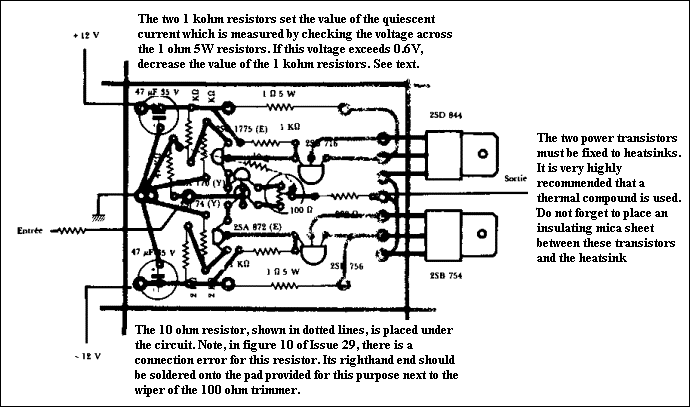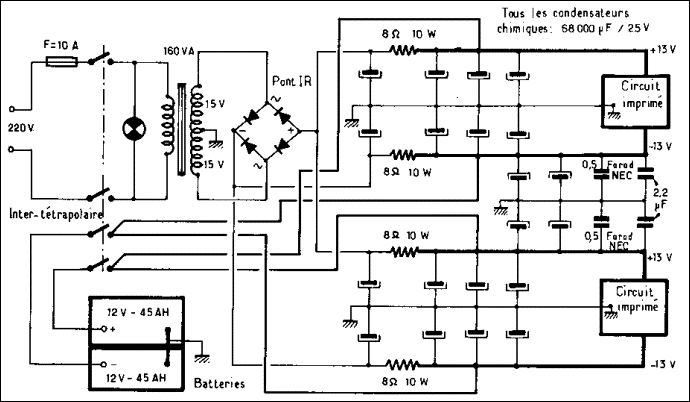The Class-A Amplifier Site
This page was last updated on 16 July 2001
“The Monster” Revisited
Jean Hiraga
(l’Audiophile No. 31)
Described in Issues 27 and 29 of l’Audiophile, this amplifier is acquiring a very solid reputation in the small world of the perfectionist audiophile. Several hundred have already been built since May 1983, and the feedback that we have had from our readers is unanimous, this amplifier made the difference! Surprisingly, this amplifier, which was originally designed to feed the mid-range and treble in multi-amplified systems, gives extraordinary results in the bass. We have carried out various tests and it is true that, on signals that don’t require a very high energy level in the bass region, the 8W has a quality of reproduction in this register that is without equal. The sound is remarkably graded, revealing an unsuspected variety of sound colours that it is rare to hear from a reproduction system. It will be necessary to wait for the 50W Kanéda, which (as you have seen in this Issue) is in preparation, to obtain these qualities at a higher power level.
The various tests in the bass register that we have been able to make, very clearly highlight the differences that exist between configurations 1, 2 and 3 mentioned in Issue 29. There is no doubt that the Monster proves to be superior to the two other configurations, especially version 1 without the battery. The advantage of batteries used on their own, or as a buffer for the mains supply, appears very clearly in broad band listening. The reason can be seen very simply and very clearly with a dual trace oscilloscope. One trace displays the output signal and the other trace the behaviour of the alternative power supplies. The amplifier is fed with a sinusoidal signal that is varied in frequency. It can be very clearly seen, starting at 50Hz, that when one decreases the frequency, the charge frequency, which is obviously that of the mains, is not sufficiently fast to feed the power supply filter capacitors. One would think that a capacitance of half a Farad, or even 1 Farad, would be sufficient to alleviate this slowness, but this is not so, and a modulation signal is found on the power supply which, similar to a piece of gelatine, fluctuates according to the signal. Of course, one could think that, below 50 Hz, a little distortion introduced by the power supply is not very critical. This would be to forget that the amplifier is required to reproduce higher frequency signals at the same time that, in addition, have much lower amplitudes in the mid-range and treble registers. Thus the noise introduced by the power supply will mask all the small amplitude signals. The overall performance will lose clarity and definition.
The battery makes it possible to cure this deficiency by providing energy between the alternations of the mains.
Following the article in Issue 29, many readers have asked if, in the "Monster" version, the mains supply was used only to charge the two large 40 A/h batteries. In fact, two modes of use are possible. The batteries can be used as the only power supply source, but take heed, the endurance hardly exceeds a few hours, lead-acid batteries are sensitive to deep discharges and their lifespan depends on this, so 12.2V is a lower limit that, above all, should not be exceeded. The second mode, which is the one that which we most usually employ, consists of using the batteries only as a buffer, with the mains charging the power supply permanently. Of course, in this solution, the power supply noise rises considerably, by 30 to 40 dB. However, in spite of this, the Monster remains an amplifier without rival, even if it loses in "luminosity" compared to its operation on batteries and without a mains supply.
Whichever configuration is chosen, the construction of the amplifier does not pose any problems. For installation in the chassis, the reader can refer to Issue 15 of l‘Audiophile (unfortunately no longer available) in which the construction of the 20W Hiraga is described. It is advisable to follow the broad outline in the article that relates to the earth wiring in order to make the positive and the negative of the power supply perfectly symmetrical so that the filter ripple (as well as the rectifier switching peaks and transformer saturation non-linearities), which arrives in opposite phase on each positive and negative rail, is cancelled. It will be necessary to provide, even for configuration 1, a case with dimensions sufficient to accept configuration 2. The transfer from configuration 2 to configuration 3 is achieved by the addition of another box. Indeed, it would be a shame to deprive oneself of the almost unlimited upgrading capabilities of this amplifier.
For the layout of the electronics, the construction is extremely simple, the two small printed circuits are fixed by means of the power transistors to the heatsink. It is very highly recommended a thermal compound be used. Two nylon spacers clipped to the heatsinks receive the card at the two corners opposite the power transistors.
One should not lose sight of the fact that the 8W functions in class A. The quiescent current therefore has a prime importance. Its value should not be too low otherwise the amplifier will pass into class AB on strong signals, nor too high because it would impose too great a dissipation on the power transistors which, in addition to the fact of limiting their lifespan, can lead to thermal runaway. Indeed, the characteristics of the power transistors are related to the temperature of the junctions and beyond a certain threshold there is runaway, that is to say the more the temperature rises the more the current increases. The optimal value lies between 0.5 and 0.6A.
To measure the quiescent current, it is sufficient to measure the voltage across the 1 ohm 5W resistors. The voltage must therefore be between 500mV and 600mV. After sorting the batches of transistors, 2SD844/2SB754 on the one hand and 2SB716/2SD756 on the other, one can be placed in non-optimal operating conditions from the point of view of quiescent current. The remedy is extremely simple. If the quiescent current is too high, it is enough to decrease the bias resistors of 2SB716 and 2SD756 transistors, whose initial value is 1 kohm. These resistors coming from the bases of the transistors determine their point of operation and consequently the collector current, on which depends the quiescent current. In general, it is enough to change from 1 kohm to 910 ohm for the quiescent current to take the correct value again.

The value of the supply voltages must be between 12V and 13.5V. If however the measured value exceeds this voltage, it is appropriate to very slightly increase the 4 ohm 20W filter resistor. A voltage value that is too high does not present a risk to the circuit if the value of the quiescent current does not exceed the limits for the current mentioned previously. However, in the ultimate version where 0.47 Farad Supercaps are used, the supply voltage should not exceed 13.5V under any circumstances.
To finish, it is advisable to carry out the adjustment of the output offset voltage, that is to say the dc potential difference appearing between the positive and negative loudspeaker output terminals. It is advised that this adjustment is made twice. Before power is first applied, place the wiper of the 100 ohm trimmer at the mid point of its track, measure the voltage (without your preamplifier or your active filter connected) and adjust the wiper of the trimmer to cancel the dc voltage at the output (voltmeter range 100 or 200mV dc). Let the amplifier find its point of thermal operation, 20 to 30 mins, and perfect the adjustment. Constructed well, the 8W amplifier has an exemplary stability, the offset does not exceed a few tens of millivolts. In any event, there is no absolutely point in tearing one’s hair out trying to obtain an offset of 0mV! Realise that 100mV offset represents a power of 1.25mW! Finally, at the request of very many readers, we publish the detailed power supply diagram for the 8W "the Monster" configuration.

HISTORY: Page created 12/07/2001
16/07/2001 Text added